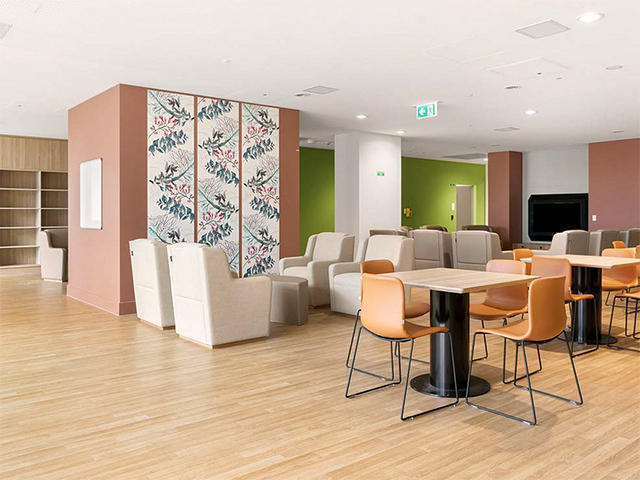Anti-Ligature Furniture: Balancing Functionality, Safety, and Aesthetics

When it comes to designing furniture for psychiatric hospitals, correctional facilities, and healthcare settings, safety is the top priority. Anti-ligature furniture, designed specifically to prevent self-harm and suicide, plays a critical role in these spaces. But achieving the right balance between safety, functionality, and aesthetics is a key challenge for designers. Not only must these pieces be practical, but they also need to create an environment that fosters healing, comfort, and a sense of security.
In this article, we'll explore what anti-ligature furniture is, why it's important, and how designers are overcoming the challenge of creating pieces that are both safe and aesthetically pleasing.
What is Anti-Ligature Furniture?
Anti-ligature furniture is specially designed to reduce the risk of self-injury and suicide by preventing individuals from attaching ligatures (like cords or fabric) to furniture and using them to harm themselves. In high-risk environments"such as psychiatric wards, mental health facilities, and prisons"anti-ligature furniture helps ensure that patients or inmates can't use the furniture to create nooses or other forms of self-harm.
Common Features of Anti-Ligature Furniture:
-
Rounded or Flush Edges: Sharp corners and protruding components are eliminated to reduce the risk of injury or ligature formation.
-
Fixed Components: Features like armrests, cushions, and fasteners are non-removable and securely attached.
-
Smooth, Seamless Surfaces: Designed to eliminate any gaps or hooks where ligatures could be tied or anchored.
-
Durable, Easy-to-Clean Materials: Furniture is made from materials that are tough, non-porous, and resistant to damage, ensuring long-term use and easy maintenance.
Why is Anti-Ligature Furniture Essential in Healthcare and Correctional Facilities?
Anti-ligature furniture isn't just about protecting people from harm"it's about creating spaces where individuals feel safe, supported, and cared for. Here are some of the most important reasons why anti-ligature furniture is critical in mental health and correctional environments:
1. Preventing Self-Harm and Suicide
Suicide and self-harm are major concerns in psychiatric hospitals, rehab centers, and correctional facilities. According to the National Institute of Mental Health (NIMH), individuals in high-stress environments are at an elevated risk. Anti-ligature furniture helps prevent the opportunity for individuals to use furniture fixtures to harm themselves, ultimately saving lives and reducing the risk of tragic incidents.
2. Supporting Healing and Recovery
Mental health recovery doesn't just happen in therapy sessions"it's also influenced by the physical environment. Anti-ligature furniture supports the creation of a healing space that prioritizes both safety and comfort. By providing safe, durable, and comfortable furniture, healthcare providers can help foster a more supportive environment that enhances the well-being of patients.
3. Meeting Legal and Ethical Standards
Healthcare facilities, correctional institutions, and mental health centers have a legal responsibility to provide safe spaces for their residents. Not implementing anti-ligature furniture could open up these facilities to lawsuits, public scrutiny, and reputational damage. Therefore, adopting these safety measures is not just about compliance but also about fulfilling ethical obligations to care for vulnerable populations.
The Challenge of Balancing Safety with Aesthetic Design
Anti-ligature furniture must strike a delicate balance between functionality and aesthetics. While safety is paramount, designers must also take into account the emotional impact that the physical environment can have on individuals. Stark, institutional furniture may unintentionally increase feelings of distress or anxiety"something that is particularly important to consider in psychiatric care settings.
1. The Risk of Cold, Institutional Designs
Many anti-ligature designs feature minimalist or utilitarian styles with hard edges, plain surfaces, and neutral colors. While these designs are effective at ensuring safety, they can create a cold, impersonal atmosphere. A visually uninviting environment can increase stress levels in patients or inmates, impeding their overall sense of well-being.
2. Comfort vs. Durability
Anti-ligature furniture needs to be both comfortable and durable. Durable materials help ensure the furniture lasts through heavy use, but they often don't provide the softness or cushioning that people expect from comfortable seating. Finding a solution that combines durability with ergonomic design is key to making anti-ligature furniture both practical and comfortable.
3. Color and Texture Choices
In environments focused on mental health, colors can play a significant role in calming patients and reducing anxiety. Soft blues, greens, and earth tones are often used to promote a sense of calm. However, achieving this effect without sacrificing safety or durability requires thoughtful consideration of materials. Textures, patterns, and even the use of faux-wood finishes can soften the clinical look of furniture while still adhering to anti-ligature principles.
Examples of Anti-Ligature Furniture Innovations
Several companies have been at the forefront of creating anti-ligature furniture that balances safety with style. Here are a few examples of brands that have excelled in this area:
1. Herman Miller Healthcare Series
Herman Miller, known for their high-quality office furniture, has developed a healthcare series that includes anti-ligature chairs and seating solutions. These pieces maintain a modern, stylish look while incorporating rounded edges, smooth surfaces, and non-removable parts. The ergonomic design ensures comfort, and the overall aesthetic is clean and inviting, making the furniture suitable for healthcare environments without feeling too institutional.
2. Sodexo Behavioral Health Solutions
Sodexo offers a range of anti-ligature furniture designed for behavioral health facilities. Their products incorporate natural materials like faux-wood finishes, helping reduce the institutional look while maintaining safety. The clean lines and soft materials help create a welcoming, non-threatening atmosphere that's ideal for patients in psychiatric care.
3. Steelcase Health Furniture
Steelcase offers a variety of solutions for healthcare environments, including anti-ligature furniture that combines durability and comfort. Their products feature soft-touch materials and integrated cushions that are designed to withstand frequent cleaning and heavy use. With an emphasis on both safety and patient comfort, Steelcase furniture is tailored for environments where well-being and security must go hand in hand.
Future Trends in Anti-Ligature Furniture Design
As the awareness of mental health issues continues to grow, the demand for anti-ligature furniture is expected to increase. The future of anti-ligature furniture design may include even more innovative features, such as:
-
Smart Furniture with Integrated Technology: Embedded sensors could monitor a patient's vital signs or alert staff to potential issues.
-
Sustainable Materials: As the healthcare and design industries place more emphasis on sustainability, anti-ligature furniture may feature eco-friendly materials that are both safe and durable.
-
Biophilic Design: The incorporation of natural elements like plants and natural light can enhance mental well-being, offering a more healing environment for patients.
Conclusion
Anti-ligature furniture plays a crucial role in protecting individuals in psychiatric hospitals, mental health facilities, and correctional institutions. By removing potential ligature points, these pieces help prevent self-harm and enhance overall safety. At the same time, they must be functional, comfortable, and aesthetically pleasing, helping create an environment conducive to recovery and well-being.
As the demand for safer and more supportive environments grows, the future of anti-ligature furniture design will likely see even more innovative solutions. By continuing to balance safety, comfort, and aesthetics, designers will ensure that these spaces are not only safe but also welcoming and supportive of the people who spend time in them.
MORE



